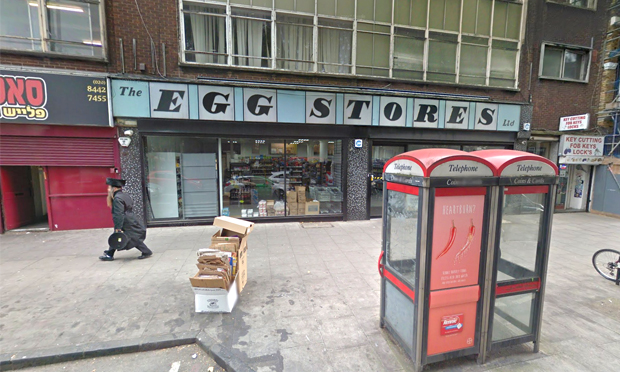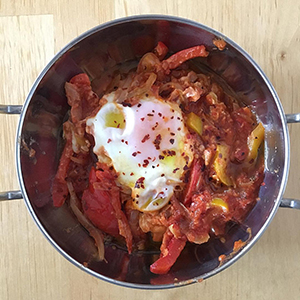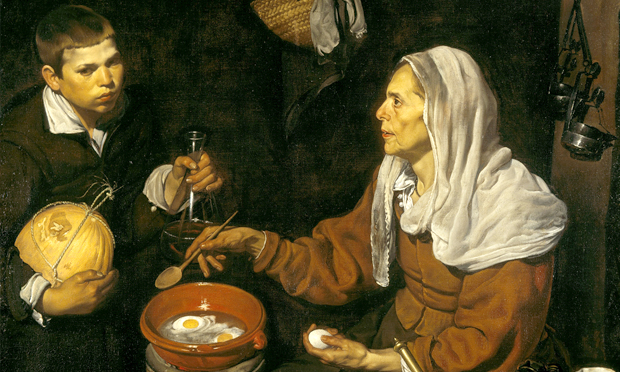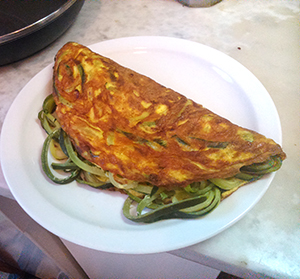Walking on eggshells: Gillian Riley on eggs, featuring global recipes and some cracking history

The Egg Stores, on Stamford Hill. Photograph: Google Street View
Our always hungry legionary is no longer puzzled by the strange name – The Egg Stores – on the Jewish food shop in Stoke Newington which faced him as they lined up for the long trudge up Stamford Hill to Hadrian’s Wall, carrying shield, sword, javelin, provisions, cooking pot, quern and clean underwear.
(A mule to carry stuff was sometimes permitted, but slowed things down, a strong well-fed legionnaire moved much faster).
When they got to Vindolanda, the garrison town near Hexham, his reputation for crafty food sourcing put our friend in charge of the victualling for his squad or contubernium, (a legion, about 5000 men, was subdivided into smaller groups: cohort, century, and finally the contubernium, eight men who lived and fought and ate together).
A typical shopping list has survived in a cluster of wooden tablets miraculously preserved in a midden at Vindolanda: “… 20 chickens, 100 apples if you can find nice ones, 100 or 200 eggs, if they are for sale at a fair price…”
Breakfasts
This was probably part of a week’s ration for our friend and his mates: about 3 or 4 eggs a day, maybe more; well go do the math: if there were 10 squads on duty, of 8 men each, the hen workload of one egg per day implies a flock of over 200 chickens just to keep our brave boys in decent breakfasts.
So, eggs mattered, and we know that Iron Age Britons had already reared chickens for meat and eggs. Archaeologists examine eggs from sites on Hadrian’s Wall and can tell whether an eggshell was that of a chick reared for meat and egg production, or one used for cooking. They can also tell, from the residues in pots, how chickens were cooked.
‘Go to Work on an Egg’, the slogan for the Egg Marketing Board attributed to the brilliant young writer Fay Weldon in the 1950s, was already a universal truth as the legions trudged North.
The Egg Stores is a reminder of this. Back in London our hungry legionaries might have flocked to the raucous, eclectic Bad Egg at Moorgate, or the Good Egg in Stoke Newington to try and recreate those robust breakfasts.

Shakshuka. Photograph: Jeremy Keith via Flickr
On duty in the Middle East a legionary could have enjoyed the spicy shakshuka of North Africa (I’m distorting history shamefully here, for tomatoes and peppers came much later from the New World. Maybe instead he used onions, maybe aubergines, celery, mushrooms?)
This way of cooking eggs, on a bed of savoury vegetables and herbs, makes a welcome escape from the tyranny of the rolled French omelette, whose silky not quite runny softness is difficult to achieve.
The hierarchy of egg cookery in France, from sublime soufflé, to rolled omelette to plain fried eggs, oeufs sur plat, is clear in the chilling anecdote of how Picasso, in the course of his fractious friendship with Gertrude Stein and Alice B. Toklas, dropped in unexpectedly one lunch time, hoping to sample their renowned cuisine, but the cook was instructed to prepare him two fried eggs, ‘He will understand…’ said Gertrude darkly.
The Old Woman Frying Eggs by Velazquez is a less derogatory, a tribute to the skills deployed to welcome an unexpected guest in seventeenth century Seville, with wine and cheese brought by a sulky lad, unappreciative of his grandmother’s culinary abilities.

Detail from Diego Velázquez’s Vieja friendo huevos (Old Woman Frying Eggs), 1618
Eggsploring
How I hate a perfectly cooked soufflé. The stress and agony of getting all that unnecessary fresh air into an ingredient that doesn’t need it, the misery of wondering if it will rise to perfection, the humiliation when it doesn’t, and the smug self satisfaction of those who never ever get it wrong thanks to Delia/Mrs Beeton/Jamie/Nigella and the Archangel Gabriel.
The pragmatic sformato of Italy is the ideal compromise. You can mix a cooked vegetable like spinach with ricotta and season with salt, pepper and nutmeg, stir in some beaten eggs and parmesan and bake in the oven until done; this basic mix can be elaborated with some béchamel, and the egg whites can be beaten to a froth if you can be bothered, but there is really no need to unmould the cooked dish as the name implies, and it can be eaten hot or tepid.
The classic Spanish tortilla or the Italian frittata is another happy way of using egg power to combine different flavours and textures. Both are best eaten at room temperature, to appreciate the flavours that develop as the dish cools.
Whether you add onion to the traditional potato in the Spanish tortilla, and whether or not to brown it/them is a topic that can cause much soul-searching, as Guardian readers will have enjoyed in Felicity Cloake’s forensic look at the various versions.

Frittata con zucchina. Photograph: Franco Dal Molin via Flickr
Rome’s simple frittata di zucchine made with tasty young courgettes, and like the tortilla using plenty of good olive oil, is deep and thick, and best eaten tepid. The eggah of the Arab world is equally benign, using eggs to bind ingredients like aubergines, or a mixture of chicken and tagliatelle flavoured with cardamom as described by Claudia Roden in her A New Book of Middle Eastern Food.
Iran’s kuku is a fresh fragrant mixture of herbs and green vegetables, lightly bound with egg, and like the other eggahs cooked slowly over a low heat, or in the oven.
Chickens were already known to the Iron Age population of Britain long before the Romans arrived, so the laying chicks at Hadrian’s wall were probably local birds, reared for their meat and eggs and perhaps as fighting cocks, a horrible enjoyment of competitive slaughter, or for divination.
Hens were domesticated somewhere in Central or South East Asia over 5000 years ago, and were brought to Egypt and Greece via India or China and hence to Europe. The Red Jungle Fowl (Gallus gallus) was crossed with other breeds of chicken to produce the productive kinds we know today.
Conditions
The current egg scare is all about the presence of Fipronil, a prohibited pesticide, in industrially prepared food using intensively produced eggs. Fipronil gets at the central nervous system and damages vital organs like liver, kidneys, spleen. But an adult would need to eat more than seven eggs a day for this to happen.
It got into our food chain through the use of naturally occurring chemicals, to which Fipronil was illegally added, to get rid of the ticks, fleas and lice that infest the premises battery hens live in.
It is absorbed through their feathers, and is not sprayed directly onto the eggs or the poor critters themselves. So the real scandal is the lifestyle we impose on hens to produce massive quantities of cheap eggs for our use, rather than the incidental risks involved in using pesticides in intensive farming.
The fluffy brown hens pictured on packs of free-range eggs, pecking contentedly in long green grass, scratching happily away at roots, shoots, grubs and bugs, would reduce a verdant meadow to an arid dustbowl in a few days, driving the unit cost per egg up from pence to pounds.
Honest organic free range eggs come at a price: from over £2 for 6, compared with just over £1 for 15 industrially produced eggs. You need a lot of space to allow the grass to grow again and give hens a happy life, adequately housed, topped up with supplementary feed and medical care.

An example of how some fowl are transported
Imagine a hot September evening on the Northern Line, (we used to call it the Misery Line), well over 4 persons per square metre, average temperature 99 – 105 Fahrenheit, humidity 55 (familiar to survivors of the Boris Buses).
Think of how some hens spend their whole lives in conditions like this, half a square foot per bird, laying eggs as well, with their nurturing instincts thwarted, and beaks cut to minimise the ensuing aggro. Are we thinking cheap eggs for the low-waged and undernourished? Or not unreasonable profits for the producers and their shareholders?
Or to end on a happier note, you don’t have to eat out to enjoy some of the recipes mentioned here, take some ethically produced eggs and vegetables, and get cracking.
